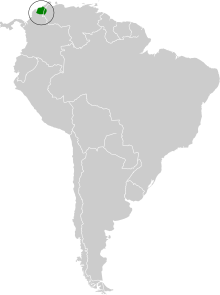Bronze tailed emerald hummingbird
| Bronze tailed emerald hummingbird | ||||||||||
|---|---|---|---|---|---|---|---|---|---|---|

Narrow-tailed emerald hummingbird and bronze-tailed emerald hummingbird illustrated by John Gould & William Matthew Hart |
||||||||||
| Systematics | ||||||||||
|
||||||||||
| Scientific name | ||||||||||
| Chlorostilbon russatus | ||||||||||
| ( Salvin & Godman , 1881) |
The bronze-tailed emerald hummingbird ( Chlorostilbon russatus ) is a species of bird in the hummingbird family (Trochilidae) that is found in Colombia and Venezuela . Here it occurs in the Sierra Nevada de Santa Marta and the Sierra de Perijá . The IUCN assesses the population as Least Concern . The species is considered to be monotypical .
features
The male bronze-tailed emerald hummingbird reaches a body length of about 8 to 8.5 cm, the female from about 7 to 7.5 cm with a weight of 3.2 to 3.6 g. The male has a short straight black beak. The front skull, the skull and the top shimmer golden green. The upper tail coverts are copper green. The underside glitters golden green. The slightly forked tail is golden-copper. The female has the same beak as the male. The anterior crown of the head and the crown of the head, the top and the upper tail-coverts are copper green. The underside is smoke gray with a little green on the flanks. The slightly forked tail is greenish copper in color. All central control springs are adorned with a copper-colored subterminal band with bright tips. Immature juveniles are similar to adult females, but have tan fringes on the head feathers. It differs from its conspecific conspecifics mainly by the strong copper tint on the tail-coverts and elytra in both sexes.
Behavior and nutrition
The bronze-tailed emerald hummingbird gets its nectar from plants from the legume , reddish , heliconias and Gesneria families . As a trapliner, it flies regularly in quick succession to very specific, scattered flowers. It also feeds on insects that it hunts in flight. Occasionally he collects them by clinging to the surface of the plant to collect the insects. He looks for the food in the lower to middle strata at heights of 4 to 12 meters above the ground.
Reproduction
The breeding season of the bronze-tailed emerald hummingbird lasts from May to June. The goblet-like nest is attached to a branch that slopes downwards about 0.8 meters above the ground. He lays this out with plant material. A clutch consists of two eggs. The incubation period lasts between 15 and 16 days and the eggs are only incubated by the female. The chicks are dark gray with two dark stripes on the back. The nestlings fledge after about 20 days. The first brood occurs in the second year of life of the bronze-tailed emerald hummingbird.
Vocalizations
Little is known about the singing of the bronze-tailed emerald hummingbird. When eating, he makes repeated tsik or tirk sounds.
distribution and habitat
The bronze-tailed emerald hummingbird prefers scrub, forest edges and cultivation areas such as plantations and farms at altitudes from sea level to 2600 meters. It occurs most often at altitudes of 500 to 1700 meters.
migration
The bronze-tailed emerald hummingbird is considered a resident bird , which occasionally migrates locally in the high areas as a line bird . The migration occurs especially after the breeding season.
Etymology and history of research
The first description of the bronze-tailed emerald hummingbird was in 1881 by Osbert Salvin and Frederick DuCane Godman under the scientific name Panychlora russata . The type specimens came from the area of Manaure , San Sebastián de Buenavista and San Jose de Oriente and were collected by Frederick Adolphus Alexander Simon . In 1853 John Gould introduced the new genus Chlorostilbon . "Chlorostilbon" is made up of the Greek words "chlōros χλωρός " for "green" and "stilbōn στίλβων " for "shining". The Greeks gave Mercury the nickname Stilbōn, which is due to the verb "stilb" for "blink". The species name "russatus" is derived from the Latin "russus" for "rust-brown, rust-red".
literature
- Ralf Bündgen, Peter Boesman in: Josep del Hoyo, Andrew Elliott, Jordi Sargatal , David Andrew Christie , Eduardo de Juana: Coppery Emerald (Chlorostilbon russatus) In: Handbook of the Birds of the World Alive . Lynx Edicions, Barcelona.
- James A. Jobling: Helm Dictionary of Scientific Bird Names . Christopher Helm, London 2010, ISBN 978-1-4081-2501-4 .
- Osbert Salvin, Frederick DuCane Godman: On some new and little-known Species of Trochilidæ . In: The Ibis (= 4 ). tape 5 , no. 20 , 1881, p. 595-597 ( biodiversitylibrary.org ).
- John Gould: A monograph of the Trochilidæ, or family of humming-birds . tape 5 , delivery 5. Taylor and Francis, London 1853 ( biodiversitylibrary.org ).
- Frederick Herschel Waterhouse: The dates of publication of some of the zoological works of the late John Gould, FRS RH Porter, London 1885 ( biodiversitylibrary.org ).
Web links
- Chlorostilbon russatus in the Red List of Endangered Species of the IUCN 2019.1. Listed by: BirdLife International, 2016. Retrieved July 26, 2019.
- BirdLife International: Species Factsheet - Coppery Emerald ( Chlorostilbon russatus ) . Retrieved July 26, 2019.
- Videos, photos and sound recordings for Coppery Emerald (Chlorostilbon russatus) in the Internet Bird Collection
- Bronze-tailed emerald hummingbird ( Chlorostilbon russatus ) at Avibase; accessed on July 26, 2019.
- Chlorostilbon russatus in the Integrated Taxonomic Information System (ITIS). Retrieved July 26, 2019.
- xeno-canto: sound recordings - bronze-tailed emerald hummingbird ( Chlorostilbon russatus )
- Coppery Emerald (Chlorostilbon russatus) in the Encyclopedia of Life . Retrieved July 26, 2019.

